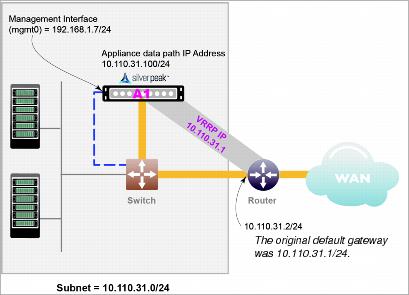|
n
|
Additionally, since you’re changing the IP address on the router interface, make sure you’re accessing the router via the console port or a different interface that’s not dependent upon the interface address you’re changing.
|
|
n
|
Also, be aware that the default priority for VRRP on many routers is 100. Refer to your router’s user documentation for the exact value.
|
In this example, setting the Silver Peak’s default priority value to 130 ensures that it’s the Primary VRRP peer.
|
n
|
With VRRP, if the Silver Peak and the router are on the same subnet as the local hosts (PCs, servers, etc.), then the virtual IP address of the VRRP group should be the default gateway address for the subnet.
|
|
•
|
The original address of the interface on the router (10.110.33.1 in this example) is the default gateway address to which all of the devices on the subnet point.
|
|
•
|
To avoid reconfiguring or rebooting all the devices on the subnet and the DHCP server to point to a new address, we’ll readdress the current router interface to a new address (10.110.31.2) and configure the virtual IP address of the VRRP group with the previous default gateway address.
|
|
•
|
This way, all devices on the subnet that previously pointed to the default gateway address, now point to the VRRP virtual IP as their default gateway.
|

